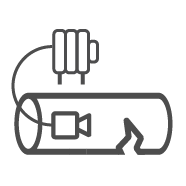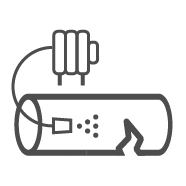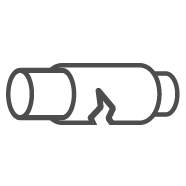Having a blocked drain in the house can be pretty frustrating. Not only does it render your toilets, showers, baths, or sinks unusable, you will also have to contend with flooding, electrical damage, and unpleasant odours.
So don’t wait until you start hearing telltale gurgling from your pipeworks (a sure sign that there’s a blockage somewhere, along with water flow being stopped up) to learn all about how to unblock a drain, specifically outside drains. This article can teach you what you need to do in the event that you run into drain blockages in your home.
Knowing the most typical reasons for drainage issues is the first step in preventing blocked drains, both inside and outside. Here are some of the top sources of drain or pipe jams.

Dead leaves or similar garden waste accumulating in the drain, as is typical during the autumn season, can prevent water from flowing properly into outdoor drains. Regularly sweeping the garden and keeping leaves or twigs from the outside drain will help the water flow freely down the drain.

Blocked drains can also come from faulty pipe installation and tree roots growing into pipes and breaking them. Problems of these kinds can’t be DIY-ed; in these cases, it’s best to call experts to take a look at and fix the issues.

Residue from the combination of paraffin in soap and the minerals in the water can build up and eventually clog drains. Decreasing the use of soap and pressure cleaning pipes can make it easier to prevent soap scum accumulation.

Falling hair can amass over time and block sink and shower drains and cause problems when they’re not taken out right away. A drain guard can help prevent hair clumps from falling into the drain.

Fat and oil can cause clogs if they’re discarded through drains and pipes, and these substances are quite difficult to remove when they harden and stick to the pipes as they cool. Experts recommend collecting any used oil into a container and disposing of it alongside solid waste.

Tampons, sanitary napkins, nappies, and baby wipes are frequent culprits in clogged toilets. These materials grow as they absorb water thereby preventing water from going further down the pipes and drains. These items should be disposed of properly in the bin or diaper pail.

Calcium and magnesium deposits from hard water can contribute to a variety of plumbing issues including pipe and drain blockage. A water softener can usually help with this, otherwise, be prepared to remove sediments regularly.

Flushing an excessive amount of mud and dirt into a sink or drain that’s not well-equipped for the volume can also burden the drains and pipes and obstruct the draining of water. Shaking off mud outdoors can ease the pressure on your plumbing
It usually takes a plumbing professional to sort out blocked outside drains, but for minor stoppages, you can apply a little know-how and some elbow grease to unblock your external drain. Don’t know where to get started with how to fix a blocked drain? Here are a few tips:
Before taking everything apart, you should know how to diagnose the problem. Luckily, the abovementioned list, “Common causes of blocked drains,” provides some ideas as to what the source of the issue might be, and where it’s likely coming from, so you can inspect it more thoroughly and then work on it, if it’s something you can handle.
Cleaning outside drains requires manual labour, starting with making sure the grate – and every size of outside drain should have one- is clear of debris. To do so, unscrew the grate and try to get to the area drain with your gloved hands to pick out what might be obstructing the water’s flow.
If you can’t reach in, you can use your drain rods, pipe snakes, or caustic soda or drain unblocker to extricate whatever’s causing the blockage.
After removing all debris, flush the drain with water and see if the water goes through normally. If the water slows or stops completely there may be a clog deeper down the line; if stronger water pressure doesn’t help, you may need to call in the professionals.
If all that hard work didn’t seem to budge what was blocking the drain, give us a call at 1300 512 737 and we’ll sort it out. Wilco Relining can solve any blockage with our step- by-step process.
Wilco Relining provides services with fully-equipped plumbers who are familiar with different kinds of sewage systems, and can ably use our relining technology to solve any drain pipe problem - without having to dig anything up!

Wilco Relining’s company of plumbers is well-versed in diagnosing a wide variety of pipework problems, using inspection, plumbing locating, and testing tools, in addition to years of experience and know-how.

If a regular hose on its highest pressure settings didn’t work, jetblasting the pipes will do the trick! Wilco Relining will apply fast and powerful streams of water that will surely loosen roots and other stubborn blockages from your pipers.

Using our state-of-the-art pipe relining technology means we won’t have to dig on your property when we reline your pipes to fix the damages caused by the tree root intrusion and broken pipes.
With a trenchless pipe relining technology endorsed by Sydney Water, you can be assured that we can help with any pipe relining needs you might have. Wilco Relining has the technology and expert manpower to address pipework and drain problems, whether big or small.
Get in touch with us and we’ll connect you with one of experts.
Let’s discuss!